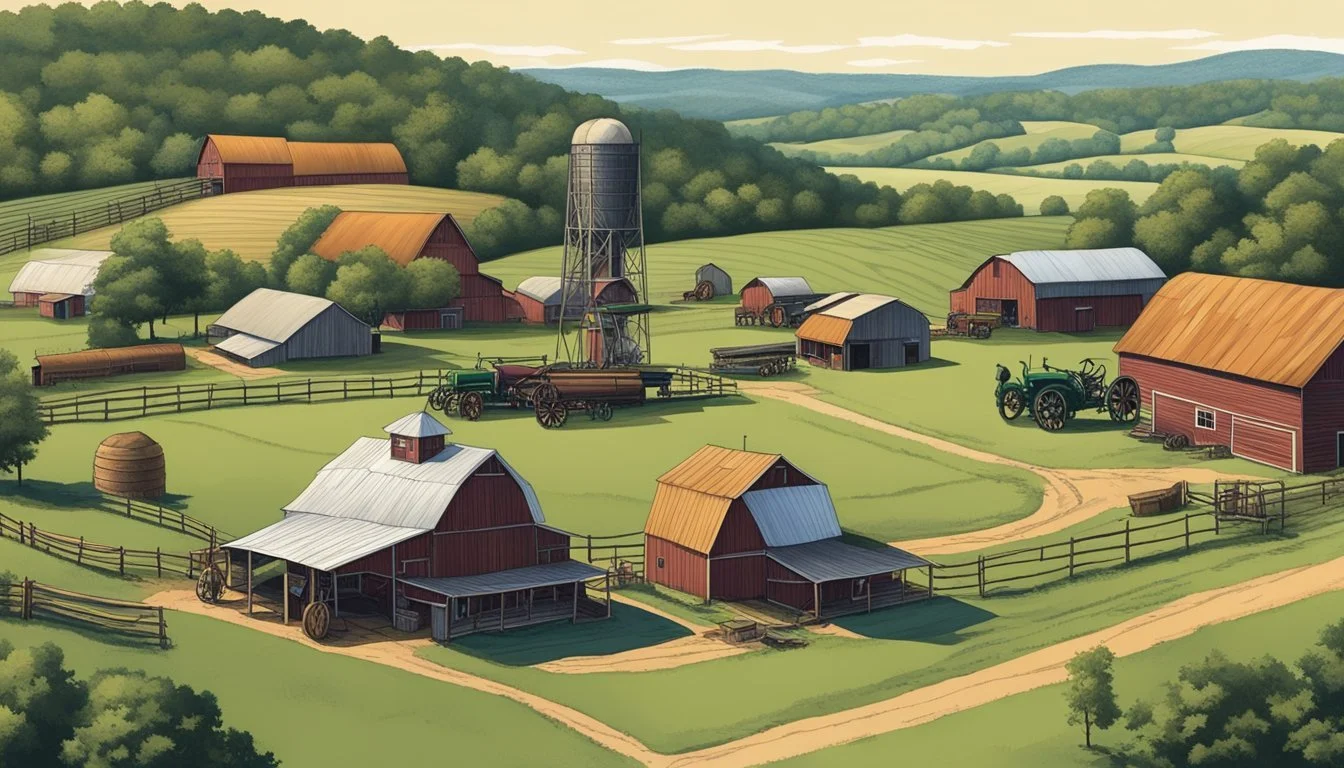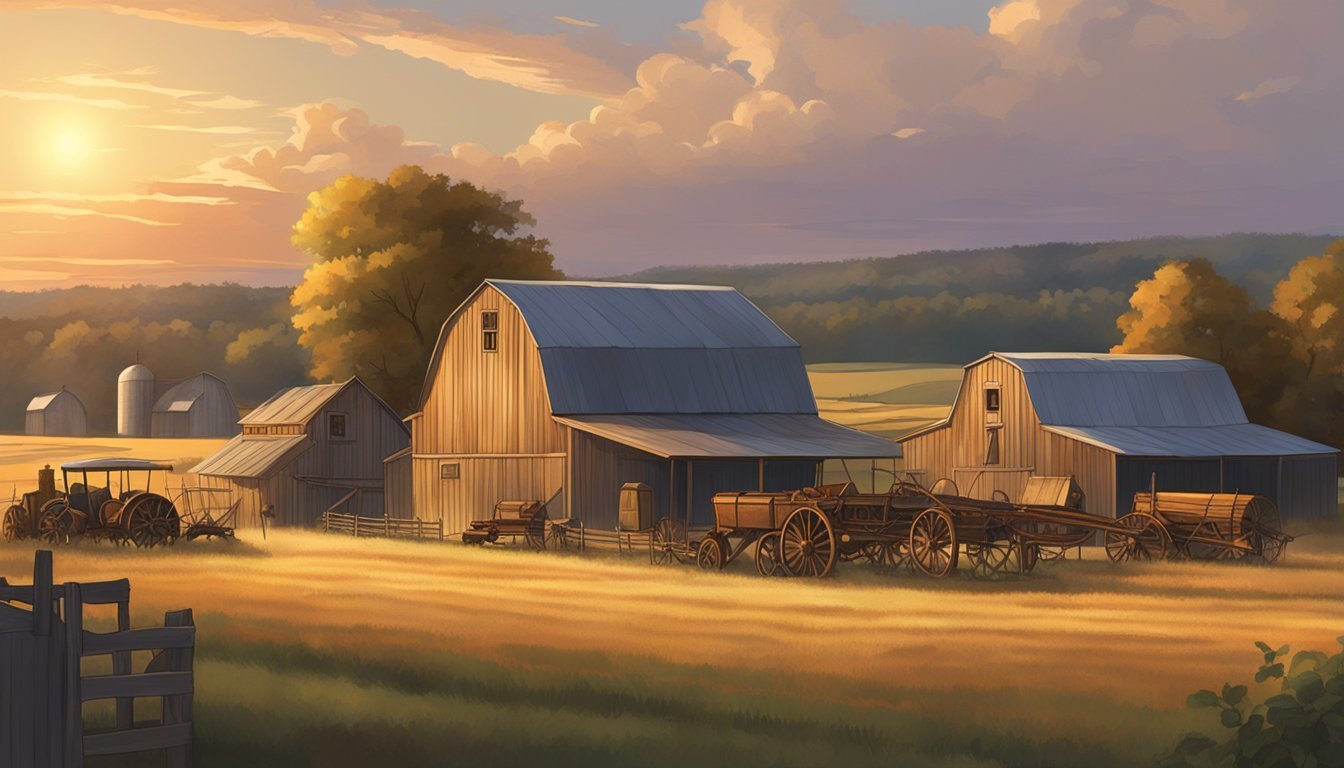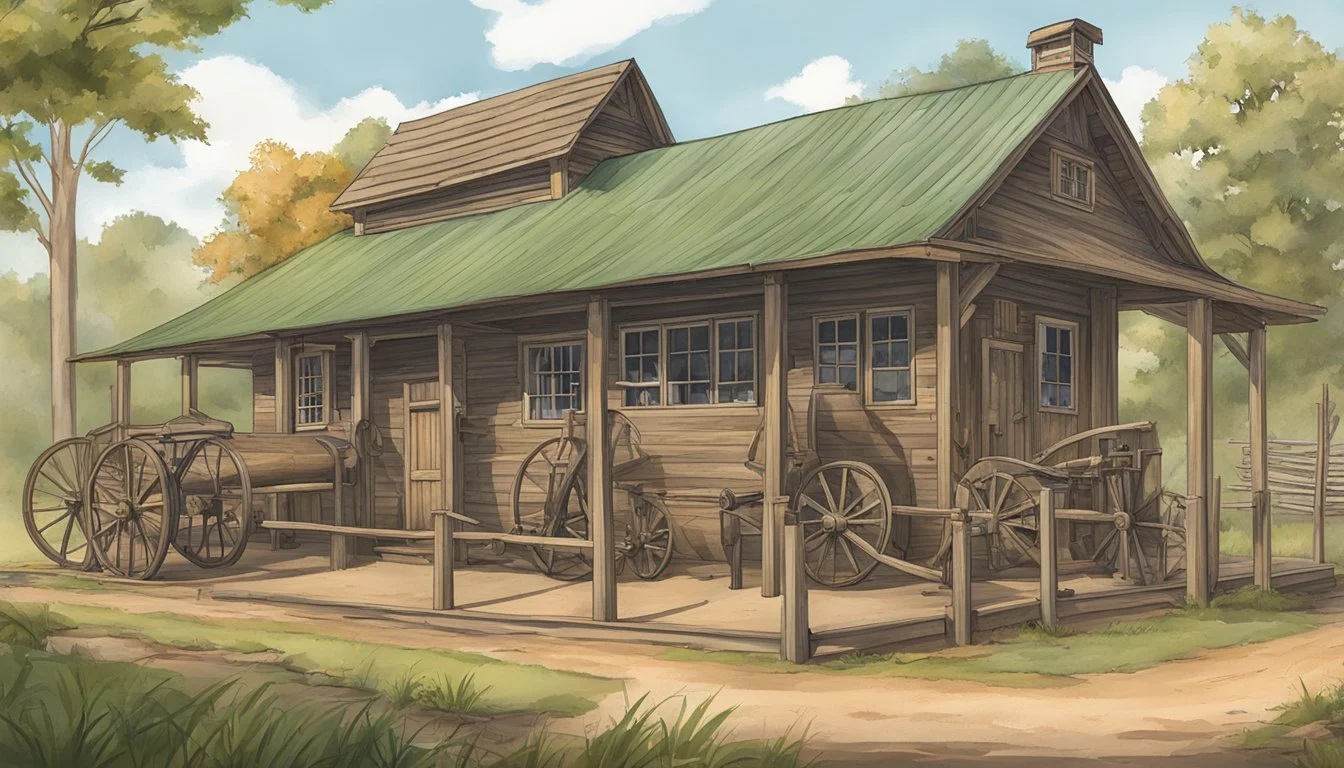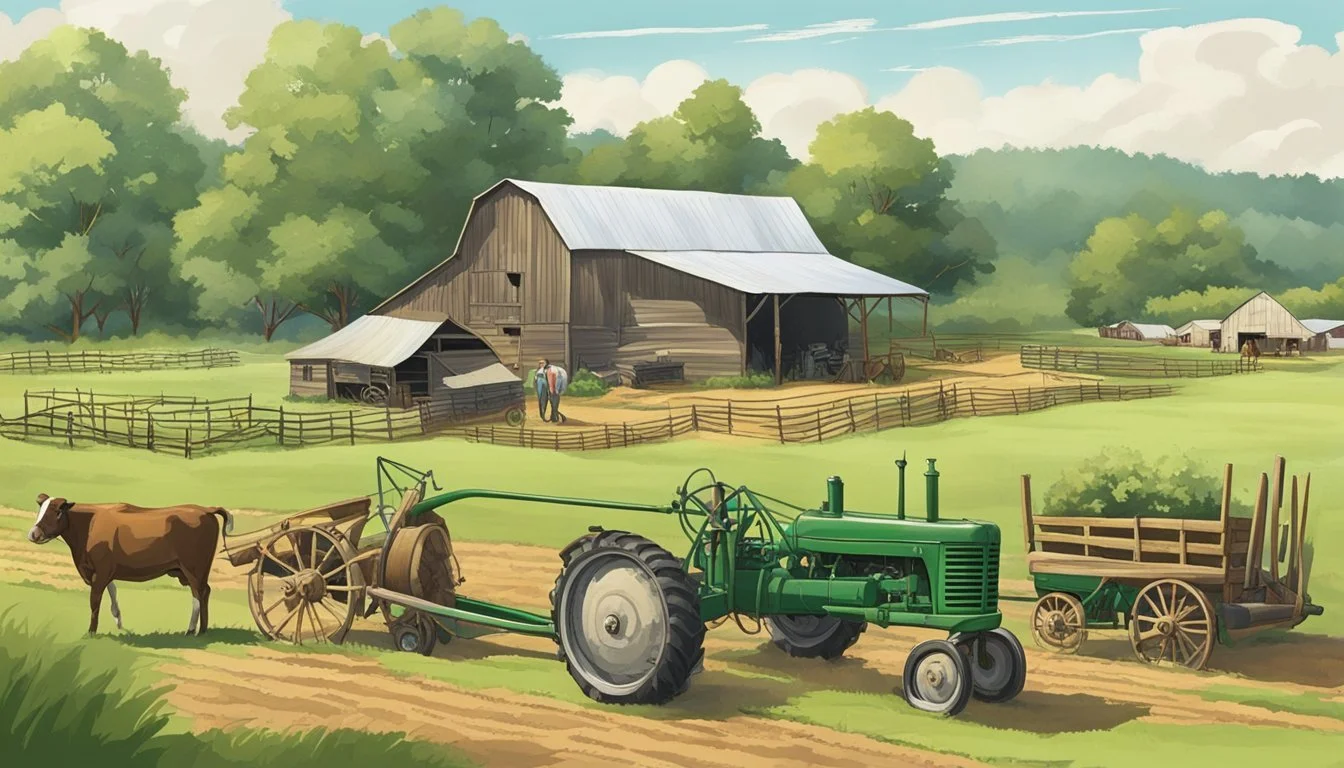Historical Farms and Agricultural Museums in Arkansas
A Guide to Agrarian Heritage
Arkansas’s landscape is rich with the legacy of its agrarian past, where farming practices have been honed over generations and have become integral to the state's identity. Historical farms and agricultural museums scattered throughout the region stand as a testament to this heritage, offering insights into the evolution of farming from the days of statehood through the mid-20th century. These institutions preserve and interpret the history of Arkansas agriculture, where cotton once reigned as the crop of choice and plantations dotted the fertile Delta region.
Visitors to Arkansas can explore this history at sites like the Plantation Agriculture Museum, where the state’s rich agricultural history is showcased through exhibits and educational programs. This museum, specifically, reveals the methods of crop cultivation and harvesting from the early 19th century up until World War II, emphasizing the technological advancements and cultural shifts that have shaped the industry.
The significance of Arkansas’ agricultural history is not only preserved in museums but also echoed in the historical farms that continue to operate and contribute to the state's economy today. Through engaging with the past, visitors and residents alike gain a deeper appreciation for the state's agricultural roots and the hard work of those who have cultivated the land through the centuries.
Historical Context of Arkansas Agriculture
Arkansas' agriculture has deep roots in the state’s history, particularly within the fertile lands of the Delta region. During the plantation era, the state was a bustling center for cotton agriculture, with vast fields of cotton shaping its economy and landscape.
Cotton was the predominant crop, and its cultivation and processing played a pivotal role in the state's agricultural heritage. The Mississippi Alluvial Plain, often referred to as the Arkansas Delta, provided rich soils conducive to growing cotton. This area was the heart of Arkansas' agricultural production due to the contributions of the Arkansas, Mississippi, and Ohio Rivers.
The Plantation Agriculture Museum, located in Scott, Arkansas, stands today as a testament to this rich history. It offers insights into the life, work, and agricultural practices during this era.
Key Exhibits at Plantation Agriculture Museum Importance Dortch Gin Exhibit Showcases a 1916 cotton gin Seed Warehouse #5 Listed on the National Register of Historic Places Historic Tractor Exhibit Commemorates technological progression in agriculture
By visiting the museum, people can observe the historic agricultural tools and learn about the plantation agriculture system that was once prevalent across the state.
Throughout the years, the state’s agriculture has evolved, yet the legacy of the plantation era still holds a significant place in understanding Arkansas' development. Contemporary museums and historic sites ensure that the stories of cultivating and harvesting cotton, as well as the lives of those who worked the land, are not forgotten.
Key Agricultural Museums in Arkansas
Arkansas has a deep connection to its agricultural roots, with several museums preserving this heritage. These institutions showcase the state's rich farming history, displaying artifacts and exhibits ranging from antebellum plantation equipment to innovations that shaped crop production.
Plantation Agriculture Museum
Located in Scott, the Plantation Agriculture Museum offers a comprehensive view of Arkansas' agricultural past. The museum, through various artifacts, brings to life the era when cotton was king. One can explore the Dortch Gin Exhibit, which features a 1920s-era cotton gin, and understand how the Dortch family and their gin shaped the agricultural landscape. The Robert L. Dortch and Floride Dortch Rebsamen collections highlight the evolution of farming tools and techniques. This venue is not only a museum but also serves as an important educational facility, managed under the Arkansas Department of Parks and Tourism.
Scott Settlement
Scott Settlement brings history to life with its living history approach to education and preservation. Visitors are transported back in time as they wander through historic structures that recreate the look and feel of a 19th-century farming community. This settlement includes a general store and other buildings that replicate the economic and social hub of rural Arkansas. The Scott Settlement's collection is a treasure trove of artifacts that illuminate the daily life, culture, and agricultural practices before and during World War II. It functions as a cultural touchstone, evoking the spirit of Arkansas’s agrarian past.
Exhibits and Collections
The heart of Arkansas' agricultural heritage is showcased through meticulous exhibitions that feature historical farm equipment and cotton processing apparatus. Visitors can expect to see authentic pieces from the state's agricultural past.
Dortch Gin Exhibit Building
In the Dortch Gin Exhibit Building, guests are privy to a restored 1920s cotton gin. The centerpiece of this exhibit is a rare, intact cotton press that offers a glimpse into the state’s cotton ginning era. Surrounded by interpretive displays, visitors understand the gin’s role in transforming raw cotton into a marketable product.
Antique Farm Equipment
The showcase of Antique Farm Equipment includes a variety of pre-1940s machinery that played a vital role in the advancement of agricultural practices. Among the collection are:
Antique tractors: Paragons of early farm mechanization, these machines highlight the transition from animal to engine power.
Steam traction engines: Once the pinnacle of technology, these engines exemplify the ingenuity of early farming.
Farm implements: From plows to planters, these tools were essential for daily farm operations.
Blacksmith tools: Indicative of the skillful craft of repairing and creating farm equipment.
Kitchen appliances: Reflecting the evolution of farm life and the modernization of the household.
Bold items provide tangible connections to agricultural history, while interactive aspects of the exhibits allow visitors to engage with the past tangibly.
Agricultural Practices and Demonstrations
In Arkansas, historical farms and museums not only preserve the physical remnants of agricultural heritage but also offer tangible insights into the farming practices of the past. Particularly, cotton planting, harvesting, and the associated processes play a pivotal role, showcased through various interpretive programs and demonstrations.
Cotton Planting and Harvesting
At sites like the Plantation Agriculture Museum, visitors can observe the traditional methods of cotton planting and harvesting that were integral to Arkansas's economy. This museum vividly portrays the cotton cycle, from sowing seeds to harvesting crops, providing an authentic representation of agricultural life on a plantation.
Spring: Preparation and planting of cotton seeds.
Fall: Manual to mechanized harvesting methods.
Interpretive Programs
Interpretive programs at agricultural museums offer educational experiences that demonstrate historical farming techniques. The Seed Warehouse #5, for example, conducts programs that explain the sorting, grading, and packaging of seeds—a testament to the innovation that transformed the industry. These programs detail the advances in agricultural technology and the time-saving devices that revolutionized farming practices.
Live Demonstrations: Showcasing historical tools and machinery.
Educational Tours: Guided walks explaining the significance of each exhibit.
These subsections capture the essence of Arkansas's agricultural history through the lens of cotton farming and educational initiatives aimed at preserving this heritage for future generations.
Cultural and Educational Events
Arkansas showcases its rich agricultural history through a myriad of cultural and educational events. These activities provide a vivid and engaging way for people to connect with the state's past farming practices and celebrations.
Living History Events
Living history events offer visitors the opportunity to witness reenactments of historical farm life. One can expect to see actors in period attire demonstrating agricultural practices as they once were. These events are often scheduled on Sundays, allowing families the chance to experience history first-hand during their weekend.
Workshops and Seasonal Celebrations
Workshops hosted by historical farms and museums focus on teaching traditional farming techniques and crafts. Interested individuals can learn from skilled artisans and take part in hands-on activities.
Seasonal celebrations reflect the agricultural calendar, with specific festivities organized around holidays. Labor Day may feature harvest-related events, while Thanksgiving Day events pay homage to the harvest's role in this holiday. Christmas Eve and Christmas Day tend to be quieter, but some places might still celebrate with themed events that highlight the seasonal aspects of farm life.
Visiting Information
When planning a visit to Arkansas's historical farms and agricultural museums, visitors should be aware of the specific opening hours, any applicable admission fees, and the facilities' accessibility features and visitor guidelines.
Opening Times and Admission Fees
Historical farms and agricultural museums in Arkansas typically operate from Wednesday through Friday, welcoming guests from the start of the day at 10:00am until the closing time of 4:00pm. While admission policies can vary by location, many museums offer free admission for all visitors. When fees are applied, they often maintain reasonable rates for adults and may provide discounts for children, seniors, and large groups.
Guidelines and Accessibility
Visitors are expected to follow certain guidelines to ensure the preservation of the historical sites and the safety of all guests. These rules often include restrictions on touching artifacts and adherence to the marked pathways around farms and along the Arkansas River. Accessibility is a priority, with many locations equipped to accommodate guests with disabilities. Services generally include wheelchair-accessible roads and buildings, as well as readily available staff assistance. Visitors who require special accommodations are encouraged to contact the museum ahead of their visit.
Community and Membership
Supporting historical farms and agricultural museums in Arkansas fosters a deeper understanding of the state's agricultural past while contributing to the preservation of its heritage. These institutions often depend on active community engagement and the support of their members to thrive.
Support and Volilunteering
Historical farms and agricultural museums, many of which are on the National Register of Historic Places, offer valuable opportunities for individuals to volunteer. Volunteers play a crucial role, assisting with daily operations, special events, and educational programs. The Plantation Agriculture Museum and the Museum of the Arkansas Grand Prairie exemplify such places where individuals can donate their time. Contributions through donations are also vital for these organizations, providing much-needed funds for preservation and education efforts.
Memberships and Benefits
Memberships provide a sustainable financial backbone to historical agricultural organizations like the Association for Living History, Farm and Agricultural Museums (ALHFAM). Membership often includes benefits such as free or discounted admission, invitations to special events held in March or other significant times in the agricultural calendar, and a subscription to informative publications. Joining as a member not only gives individuals a way to enjoy these sites but also supports their mission to educate and preserve these treasures for future generations.









